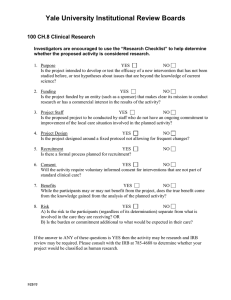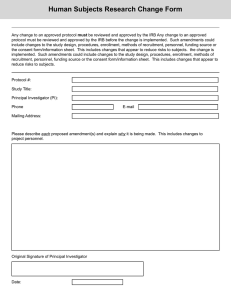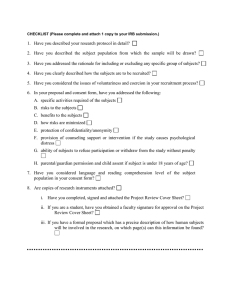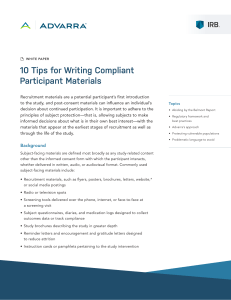Detailed Protocol
advertisement
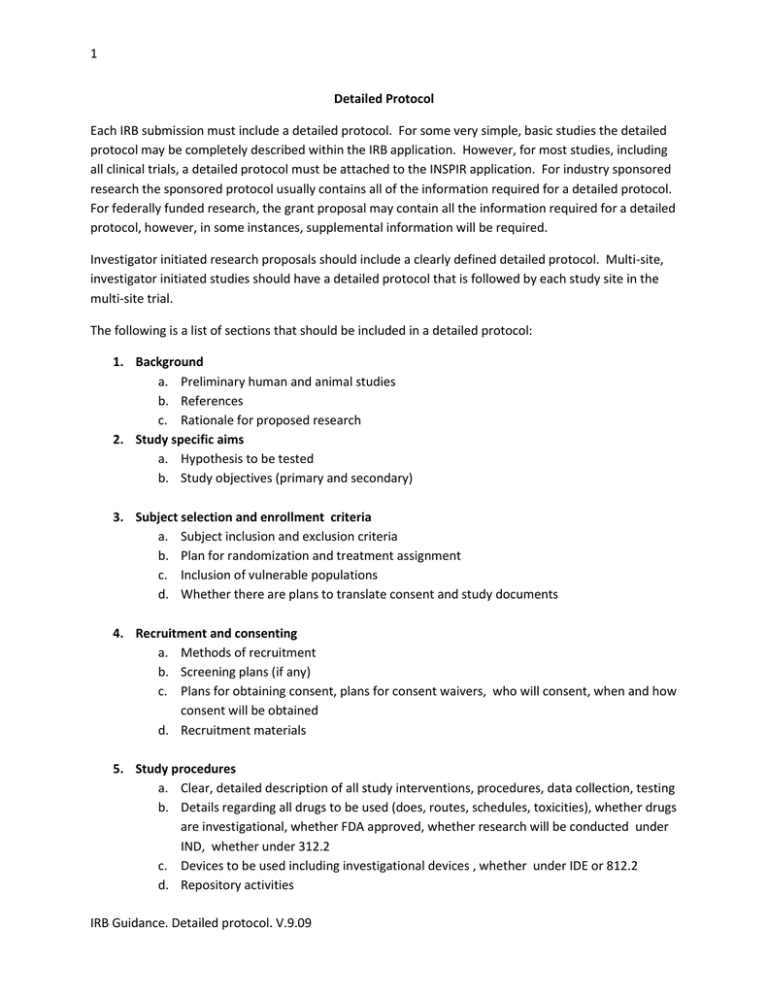
1 Detailed Protocol Each IRB submission must include a detailed protocol. For some very simple, basic studies the detailed protocol may be completely described within the IRB application. However, for most studies, including all clinical trials, a detailed protocol must be attached to the INSPIR application. For industry sponsored research the sponsored protocol usually contains all of the information required for a detailed protocol. For federally funded research, the grant proposal may contain all the information required for a detailed protocol, however, in some instances, supplemental information will be required. Investigator initiated research proposals should include a clearly defined detailed protocol. Multi-site, investigator initiated studies should have a detailed protocol that is followed by each study site in the multi-site trial. The following is a list of sections that should be included in a detailed protocol: 1. Background a. Preliminary human and animal studies b. References c. Rationale for proposed research 2. Study specific aims a. Hypothesis to be tested b. Study objectives (primary and secondary) 3. Subject selection and enrollment criteria a. Subject inclusion and exclusion criteria b. Plan for randomization and treatment assignment c. Inclusion of vulnerable populations d. Whether there are plans to translate consent and study documents 4. Recruitment and consenting a. Methods of recruitment b. Screening plans (if any) c. Plans for obtaining consent, plans for consent waivers, who will consent, when and how consent will be obtained d. Recruitment materials 5. Study procedures a. Clear, detailed description of all study interventions, procedures, data collection, testing b. Details regarding all drugs to be used (does, routes, schedules, toxicities), whether drugs are investigational, whether FDA approved, whether research will be conducted under IND, whether under 312.2 c. Devices to be used including investigational devices , whether under IDE or 812.2 d. Repository activities IRB Guidance. Detailed protocol. V.9.09 2 6. Analysis a. Sample size justification/ power analysis b. Statistical methods, study endpoints c. Data to be collected (CRFs) 7. Risks and Discomforts a. Drug side effects and toxicities b. Potential Device problems c. Potential Physical Risks (including surgical risks, radiations risks including risks of MRI, CT scans, etc. performed for research purposes) d. Potential psycho/social risks e. Risks to fetus and women of childbearing potential 8. Potential Benefits a. Potential for direct benefits to subjects b. Potential for benefits to society 9. Monitoring (including Data and Safety Monitoring) a. Safety monitoring, evaluating of AEs and SAEs, by whom, how frequently b. DSMBs – charter and membership c. Definitions of AEs, SAEs d. Reporting of AEs, SAEs, Unanticipated Problems 10. Plan to protect patient privacy and confidentiality of the data a. Repository regarding data and specimen collection and storage b. HIPAA (if applicable) 11. Study Forms a. All questionnaires, surveys, and other data collection forms that will be used b. For focus groups a description of the plan for the focus group discussion c. Data collection forms that will be used to extract data from medical records IRB Guidance. Detailed protocol. V.9.09
